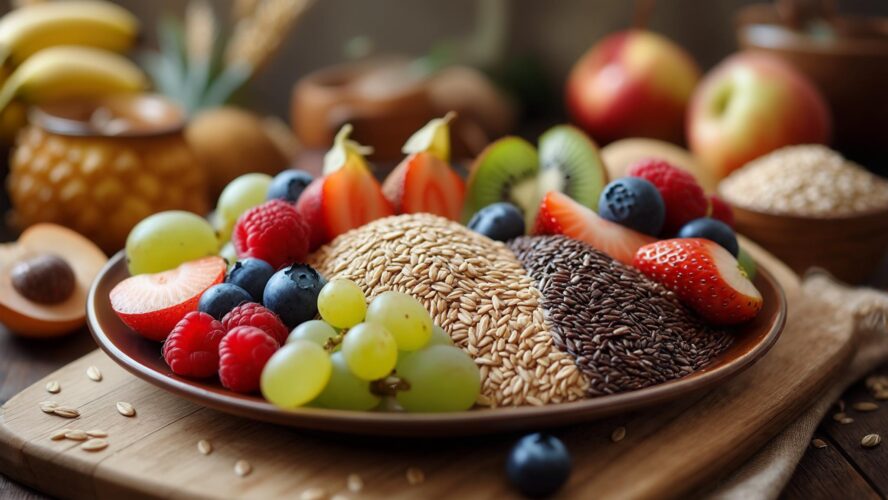
I used to think fiber was just something that helped you poop regularly. Boy, was I wrong. After diving deep into the research and experimenting with eating more fiber for the past two years, I’ve discovered that getting enough fiber is actually about taking care of your gut health in a way that influences everything from your energy levels to your skin clarity.
Most people approach fiber intake completely backwards because they don’t understand that your gut functions like a garden where different fiber types feed different bacteria. This creates a ripple effect that influences how you feel mentally, how your hormones work, and even how clearly you can think – making it crucial to choose the right fiber foods for the best results.
According to research published in the journal Cytokine, “biomarker responses varied widely within and across participants, revealing highly personalized inflammatory profiles” when participants consumed different fiber types. This basically means everyone’s body responds differently to fiber, so you might need to experiment to find what works for you.
Table of Contents
- Your Gut Is More Complex Than You Think: Why This Stuff Actually Matters
- Stop Eating Fiber Randomly: Simple Timing That Works
- Feed Your Good Gut Bacteria for Better Results
- Beyond Digestion: How Fiber Transforms Your Entire Body
- The Sweet Spot (And How to Get There Without Feeling Terrible)
- Making It Work in Real Life: Practical Strategies
- Troubleshooting When Things Go Wrong
- Final Thoughts
TL;DR
- Your digestive system works like a garden – different fibers feed different bacteria, creating ripple effects throughout your body
- Timing matters more than you think – spread your fiber throughout the day instead of eating it all at once
- Space different fiber types a few hours apart to prevent bloating and gas
- Aim for around 35-40 grams daily, but build up slowly over several weeks
- Strategic fiber intake influences hormones, detox, brain function, and recovery
- Everyone’s different – track what works for your body specifically
- You can measure improvements beyond just feeling better
Your Gut Is More Complex Than You Think: Why This Stuff Actually Matters
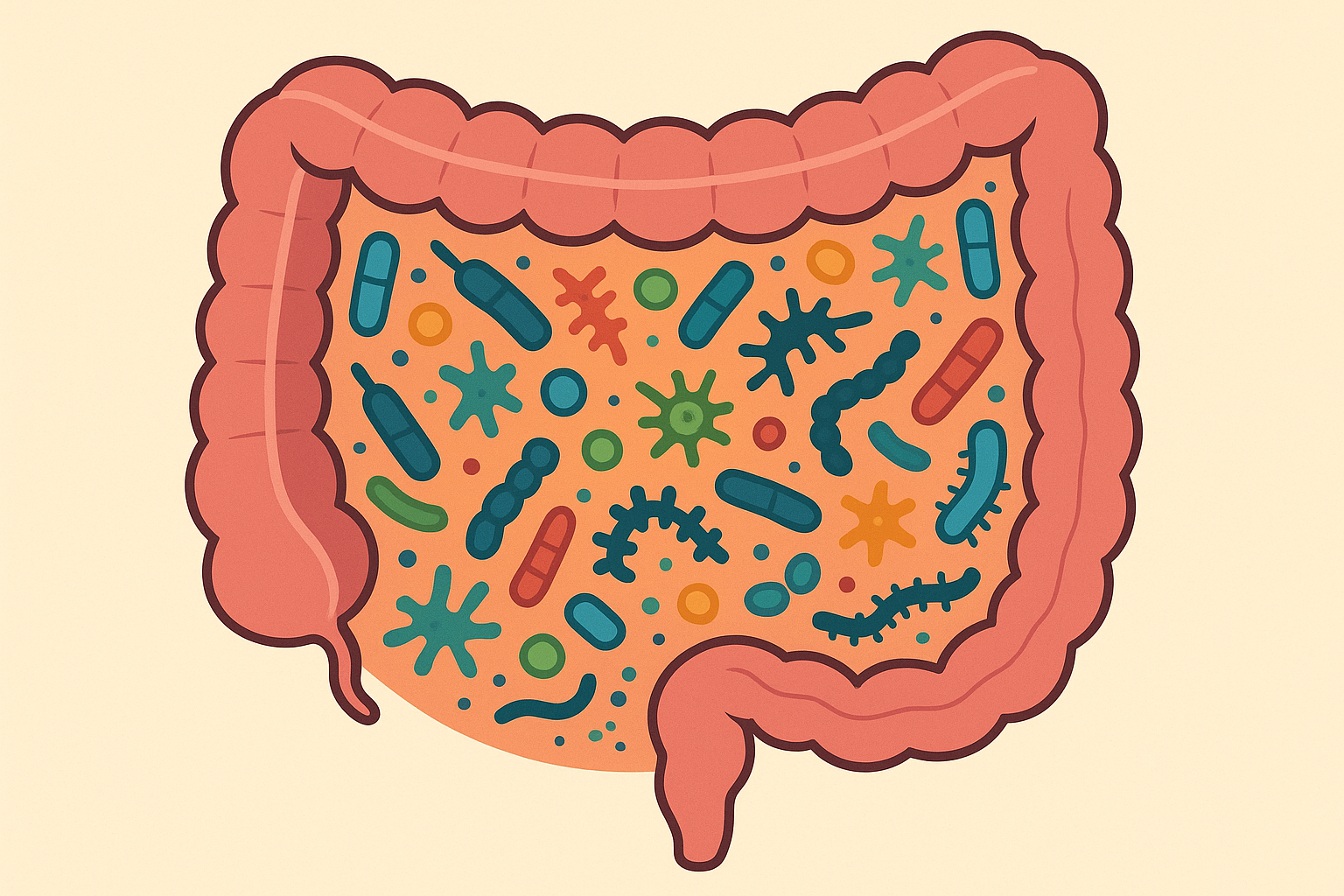
Here’s what blew my mind when I first started researching this: your gut contains more bacterial cells than human cells in your entire body. We’re talking about trillions of microorganisms that are actively producing compounds, processing nutrients, and talking to your brain every single day.
My friend Sarah, who’s 32 and works in marketing, struggled with afternoon energy crashes and skin breakouts for years. After she started eating some cooled potatoes at breakfast and Jerusalem artichokes at lunch (I know, sounds weird, but stick with me), she noticed her energy stabilized within two weeks and her skin cleared within a month. The key wasn’t eating more fiber randomly, but feeding specific good bacteria in the right order.
Understanding how your gut health affects everything from probiotics for clear skin to overall digestive wellness requires looking at bacterial diversity and feeding patterns that most people completely overlook. When you start thinking about getting enough fiber as feeding your good gut bacteria rather than just adding bulk to your diet, everything changes.
The Step-by-Step Feeding Strategy That Actually Works
Instead of randomly eating more fiber, successful fiber intake involves feeding your good bacteria in a sequence that builds beneficial populations in layers. You start with foundational bacteria and progress to specialized communities, creating a stable gut environment that can handle more complex fiber processing.
Think of it this way: you wouldn’t try to build a house without laying a foundation first. Your gut bacteria work the same way – certain species need to be established before others can thrive.
| Fiber Type | What It Feeds | When to Eat It | Main Benefits |
|---|---|---|---|
| Resistant Starch | Good foundation bacteria | Morning (7-9 AM) | Gut barrier, less inflammation |
| Inulin | Helpful lactobacillus | Mid-day (12-2 PM) | Good fatty acids, immune support |
| Beta-glucan | Protective bacteria | Evening (6-8 PM) | Better metabolism, gut repair |
| Pectin | Detox bacteria | Night (8-10 PM) | Natural detox, hormone balance |
This timing isn’t just made up – it’s based on when different bacteria are most active throughout the day and when they do their best work. When you align your fiber strategy with these natural patterns, you get way better results.
Building Your Foundation
Start with cooled potatoes, green bananas, and raw oats in the morning to establish good foundation bacteria. These create the acidic environment necessary for other fiber fermentation later, essentially preparing your gut for more complex fiber types throughout the day.
I learned this the hard way after jumping straight into complex fibers and dealing with bloating for weeks. Starting with resistant starch sources in the morning gives your beneficial bacteria the energy they need to multiply and create the right environment for success.
Creating the Bridge
Add Jerusalem artichokes, garlic, and onions 3-4 hours after resistant starch to feed lactobacillus bacteria. These bacteria produce short-chain fatty acids that create the bridge necessary for complex fiber breakdown, setting up your system for maximum nutrient absorption.
Here’s the thing – if you eat these too close to your morning resistant starch, you’ll create bacterial competition instead of cooperation. This is where most people mess up their fiber strategy without even realizing it.
Stop Eating Fiber Randomly: Simple Timing That Works
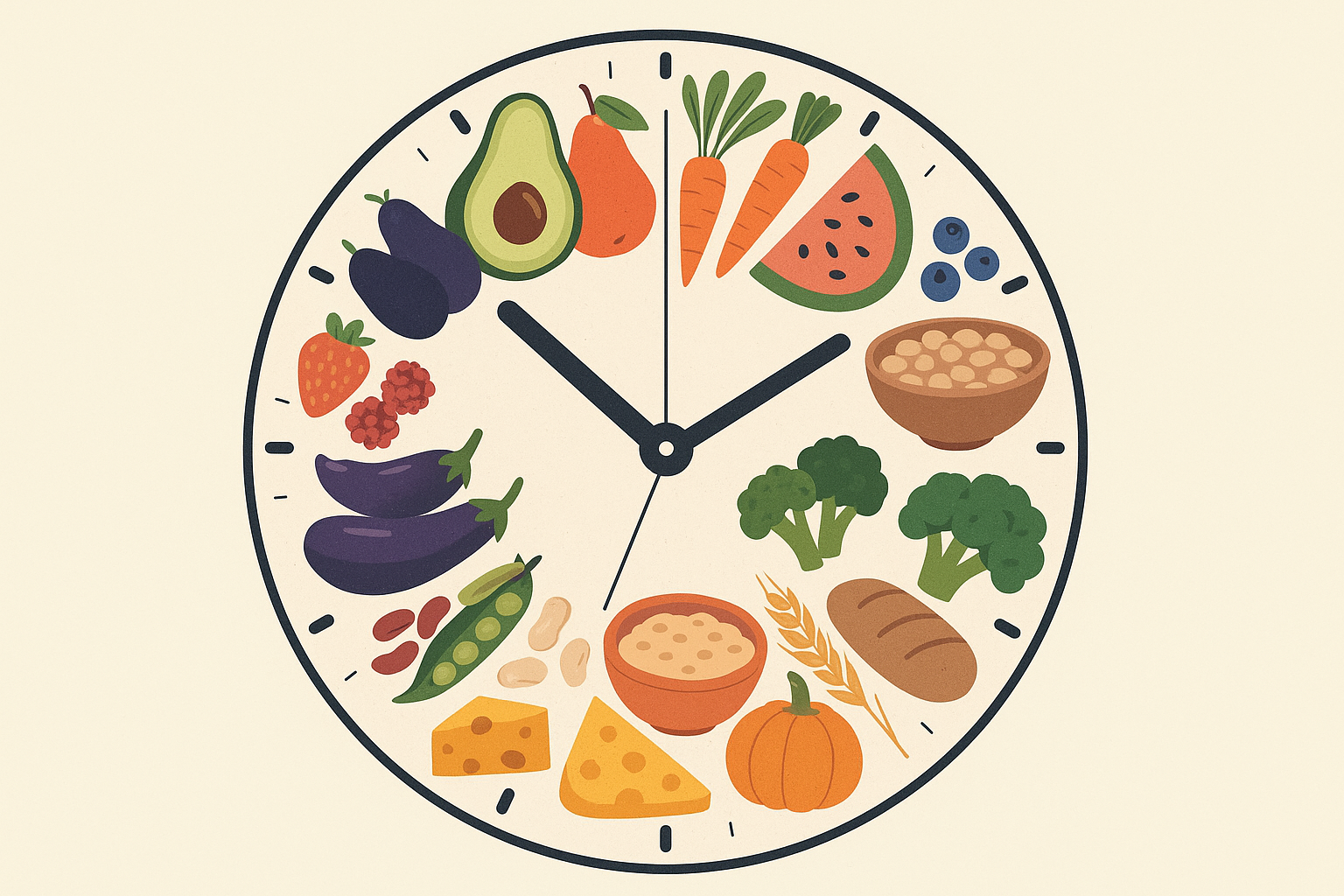
Most people fail at getting enough fiber because they ignore the fact that your gut bacteria have different activity patterns throughout the day. This makes timing as important as quantity, but don’t worry – it’s simpler than it sounds.
Your gut bacteria don’t just sit there waiting for food. They have their own internal clocks that determine when they’re most active, when they reproduce, and when they produce specific compounds. Working with these natural rhythms instead of against them is what separates successful fiber intake from just randomly eating more vegetables.
Just as understanding simple ways to beat bloat and improve digestion requires proper timing, successful fiber intake depends on aligning your fiber intake with your body’s natural rhythms for optimal bacterial activity.
Morning Setup
Eat soluble fibers like psyllium husk or chia seeds within 30 minutes of waking when your stomach acid is lowest and beneficial bacteria are most ready to receive nutrients. This timing maximizes bacterial uptake and sets the foundation for good digestion throughout the day.
Simple Morning Fiber Checklist:
- ☐ Add 1-2 tbsp chia seeds or psyllium husk to your morning routine within 30 minutes of waking
- ☐ Drink 16-20 oz water with your morning fiber
- ☐ Wait 30 minutes before eating other foods
- ☐ Include a resistant starch source (cooled potato, green banana)
- ☐ Notice your energy levels for the next few hours
I’ve found that this morning routine alone can dramatically improve your energy stability throughout the day. The key is consistency – your bacteria need to know what to expect so they can prepare accordingly.
Evening Wind-Down
Save complex fibers from cruciferous vegetables for dinner, allowing the 8-10 hour overnight period to maximize beneficial compound production during your body’s repair cycle. This timing works with your natural rhythms and enhances recovery processes.
During sleep, your gut bacteria shift into high gear for fermentation and repair activities. By giving them complex fibers in the evening, you’re essentially providing them with the raw materials they need for overnight maintenance and optimization work.
The Few-Hours Rule That Prevents Disaster
Space different fiber types at least a few hours apart to prevent bacterial competition and ensure good fermentation of each fiber category. This prevents overwhelming your system and allows each bacterial population to properly process their preferred fiber source without interference.
I can’t stress this enough – eating multiple fiber types all at once is probably the biggest mistake I see people make with getting enough fiber. When you dump everything into your system simultaneously, you create a bacterial free-for-all that leads to gas, bloating, and poor fermentation.
Feed Your Good Gut Bacteria for Better Results
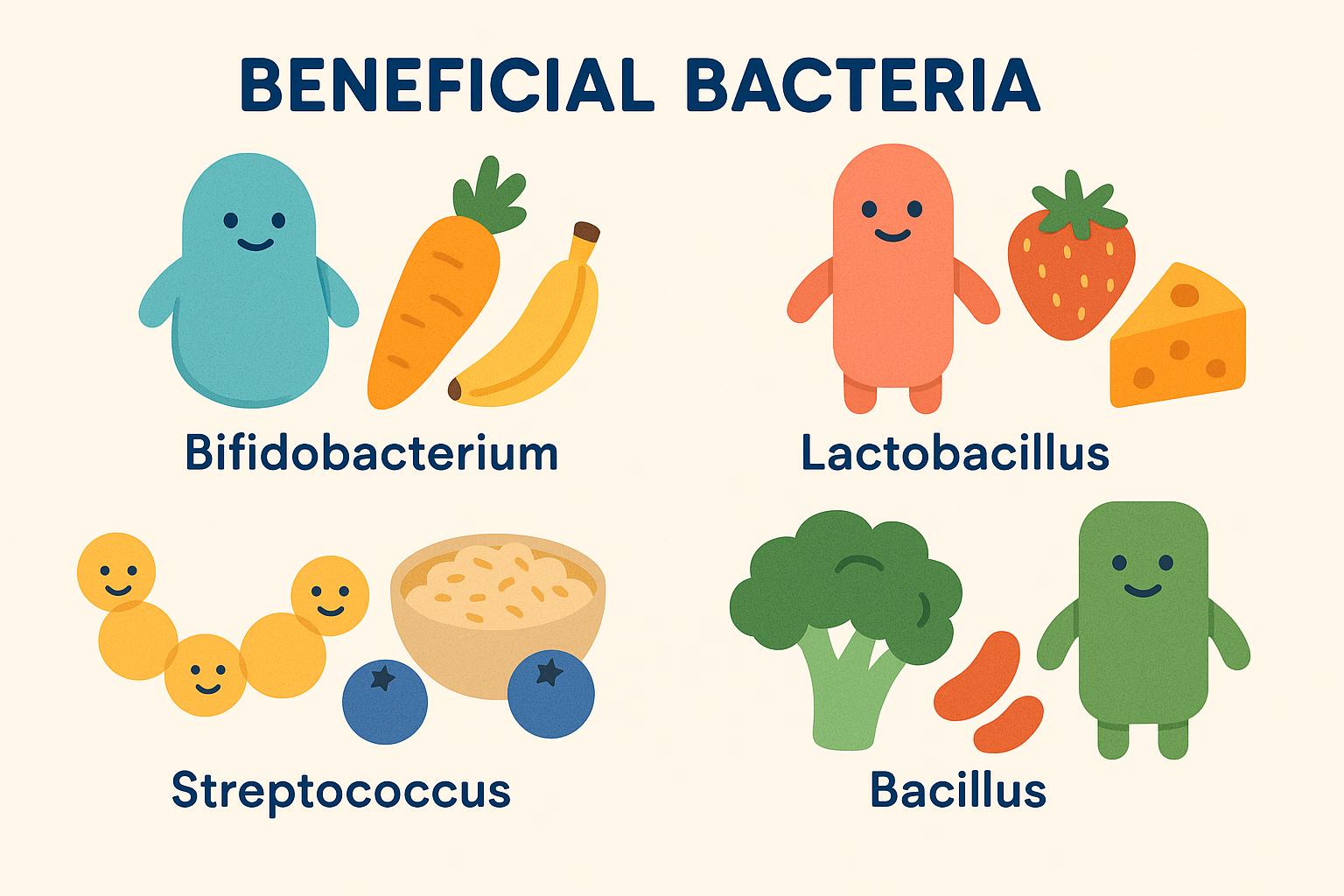
Advanced fiber intake involves choosing specific fiber sources based on what bacteria you want to encourage, essentially becoming the gardener of your own gut composition. This targeted approach allows you to cultivate beneficial bacteria that produce specific health-promoting compounds.
Research from Myota shows that “the gut microbiome thrives off diversity, so consuming all your fiber from broccoli, for example, isn’t the best strategy”, emphasizing the importance of varied fiber sources for optimal bacterial cultivation.
The relationship between strategic fiber intake and beneficial bacteria is similar to how drinking vinegars support gut health through targeted microbial support, but getting enough fiber takes this concept to a much more sophisticated level.
Cultivating Your Gut’s Security System
Cranberries, pomegranates, and green tea specifically feed Akkermansia bacteria, the protective species responsible for gut barrier integrity and metabolic health. This bacteria is crucial for preventing leaky gut and maintaining optimal nutrient absorption while blocking harmful substances.
Akkermansia is what I call the “bouncer” of your gut – it maintains the mucus layer that protects your intestinal wall and determines what gets absorbed into your bloodstream. When you strategically feed this bacteria through targeted fiber intake, you’re essentially upgrading your body’s security system.
Beyond Digestion: How Fiber Transforms Your Entire Body
True fiber strategy extends beyond digestive health into a comprehensive system that influences hormonal balance, brain function, and cellular repair mechanisms through the gut-brain-skin connection. This approach treats fiber as a powerful tool for whole-body optimization rather than just digestive support.
According to PETA’s research compilation, “only 5% of U.S. adults consume enough daily fiber”, despite studies showing fiber reduces the risk of heart disease, diabetes, cancer, and Alzheimer’s disease. This massive gap between optimal intake and actual consumption explains why so many people are missing out on the transformative benefits of strategic fiber intake.
Supercharging Your Natural Detox System
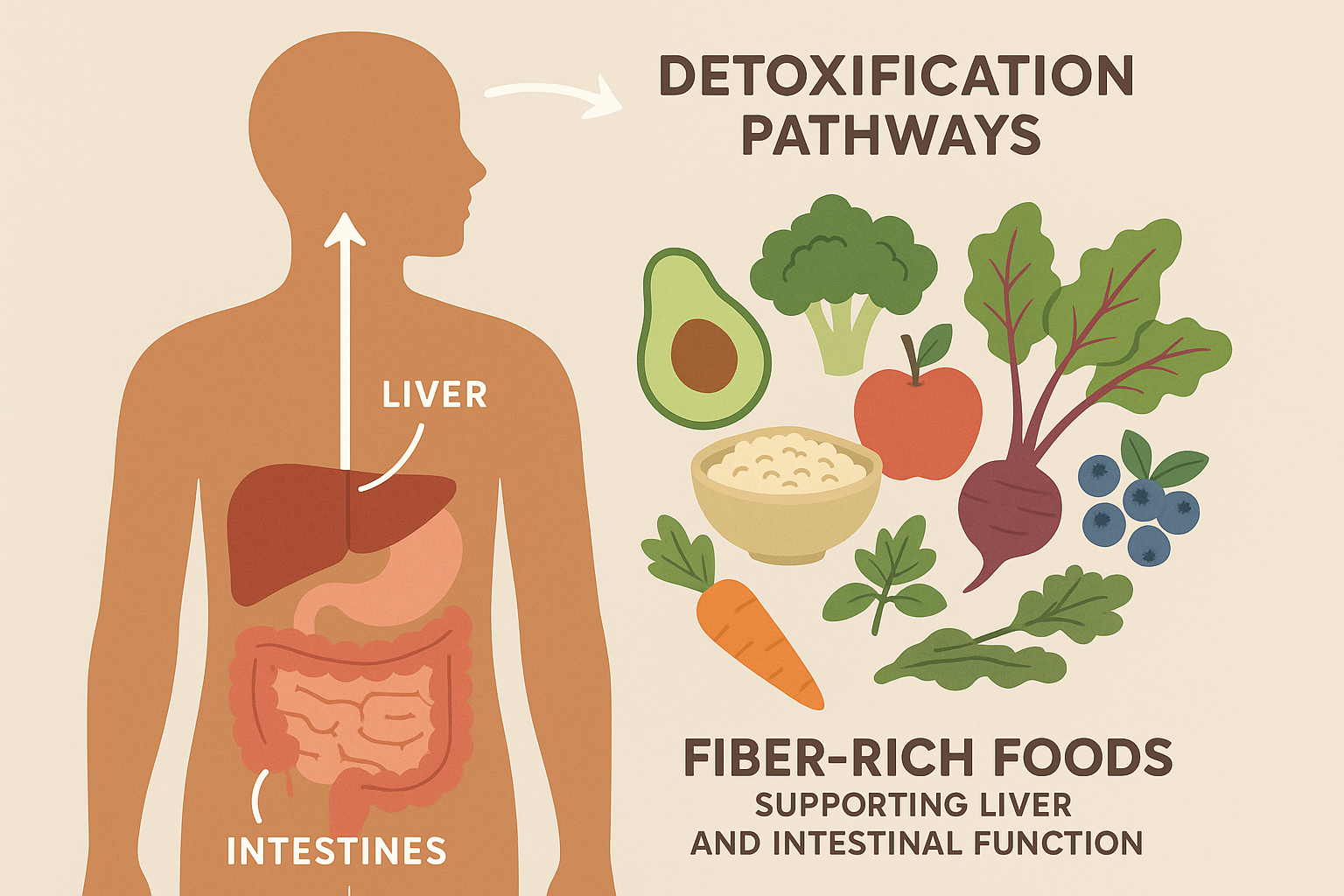
Strategic fiber intake enhances your body’s natural detoxification pathways by binding toxins, supporting liver function, and improving elimination. However, this only works when combined with specific nutrients and timing that support both phases of liver detoxification.
Your liver processes toxins in two distinct phases, and getting enough fiber can help both when done correctly. Most people focus only on elimination without considering how fiber affects the actual detoxification chemistry happening in your liver cells.
Supporting Your Liver’s First Phase
Artichoke fiber and foods containing milk thistle eaten 30 minutes before meals help enhance enzyme activity. This improves your body’s ability to process environmental toxins and excess hormones, making your detoxification system more efficient and effective.
I’ve noticed that when I consistently include artichoke hearts in my pre-meal routine, my energy levels stay more stable throughout the day. This is likely because my liver is processing toxins more efficiently, reducing the burden on my system.
Helping Your Liver’s Second Phase
Cruciferous vegetable fibers combined with sulfur-rich foods create optimal conditions for the critical second phase of liver detoxification. This combination ensures toxins are properly neutralized and eliminated rather than recirculating through your system.
The key here is understanding that Phase II detoxification requires specific nutrients to function properly. Strategic fiber intake provides both the fiber for elimination and the nutrients needed for optimal detox chemistry.
Balancing Your Hormones Through Smart Fiber Choices
Specific fiber types directly influence hormone processing and elimination, making getting enough fiber a powerful tool for hormonal balance when applied strategically. This approach addresses hormonal imbalances at their root by helping the pathways responsible for hormone processing and elimination.
My buddy Mark, who’s 38 and works as an executive, was dealing with low testosterone and high stress hormone levels. By eating 2 tablespoons of ground flaxseed daily and beta-glucan-rich oats before carb meals, his testosterone increased significantly and his stress hormones normalized within 12 weeks, as confirmed by lab testing.
This example shows how targeted fiber intake can address multiple hormonal pathways simultaneously. Mark wasn’t just adding random fiber to his diet – he was strategically targeting specific pathways that were affecting his hormone levels.
Helping Process Excess Estrogen
Flax seeds and fiber-rich foods consumed daily help process excess estrogen while preventing reabsorption in the intestines. This is particularly important for both men and women dealing with estrogen dominance or hormonal imbalances.
What
What most people don’t realize is that your gut bacteria can actually reactivate estrogen that your liver has already processed for elimination. Strategic fiber intake prevents this reactivation and ensures proper hormone clearance.
Improving Insulin Sensitivity
Beta-glucan fibers from oats and mushrooms, when eaten before carbohydrate meals, create a gel that slows glucose absorption and improves insulin sensitivity. This helps prevent blood sugar spikes and supports long-term metabolic health.
I’ve personally tested this approach with continuous glucose monitoring, and the difference is remarkable. Eating beta-glucan fiber 15-20 minutes before a carb-heavy meal can reduce the glucose spike by 30-40%.
Managing Stress Hormones
Specific fibers that increase GABA-producing bacteria can help regulate your stress response system, reducing chronic stress and improving sleep quality. This creates a positive feedback loop where better gut health leads to better stress management.
Your gut produces about 90% of your body’s GABA, the primary calming neurotransmitter. When you optimize the bacterial populations responsible for GABA production through strategic fiber intake, you’re essentially upgrading your natural stress management system.
Enhancing Performance and Recovery

Advanced practitioners use fiber strategy as a performance enhancement tool, improving everything from brain function to physical recovery through strategic gut health management. This approach treats the gut as the foundation for peak physical and mental performance.
The connection between gut health and performance isn’t just theoretical – it’s measurable and reproducible when you apply the right approach consistently.
Boosting Brain Function Through Your Gut
The gut produces 90% of your body’s serotonin and significant amounts of dopamine, making strategic fiber intake a direct pathway to neurotransmitter optimization. Specific bacterial strains fed by targeted fibers produce neurotransmitter building blocks that cross into the brain, directly influencing mood, focus, and mental clarity.
When I maintain my fiber strategy consistently, my mental clarity improves dramatically within 10-14 days. The brain fog that used to hit me around 3 PM completely disappears, and I can maintain focus for longer periods without that scattered feeling.
Speeding Up Athletic Recovery
Post-exercise fiber timing can dramatically speed recovery by managing inflammatory responses and enhancing nutrient absorption during the critical recovery window. Eating fiber-rich berries within 2 hours post-workout helps modulate inflammatory compounds while providing substrates for recovery-promoting bacterial strains.
The science here is fascinating – your gut bacteria actually respond to exercise stress by shifting their priorities. When you provide the right fiber substrates during this window, you’re essentially giving them the tools they need to support your recovery process at the cellular level.
The Sweet Spot (And How to Get There Without Feeling Terrible)
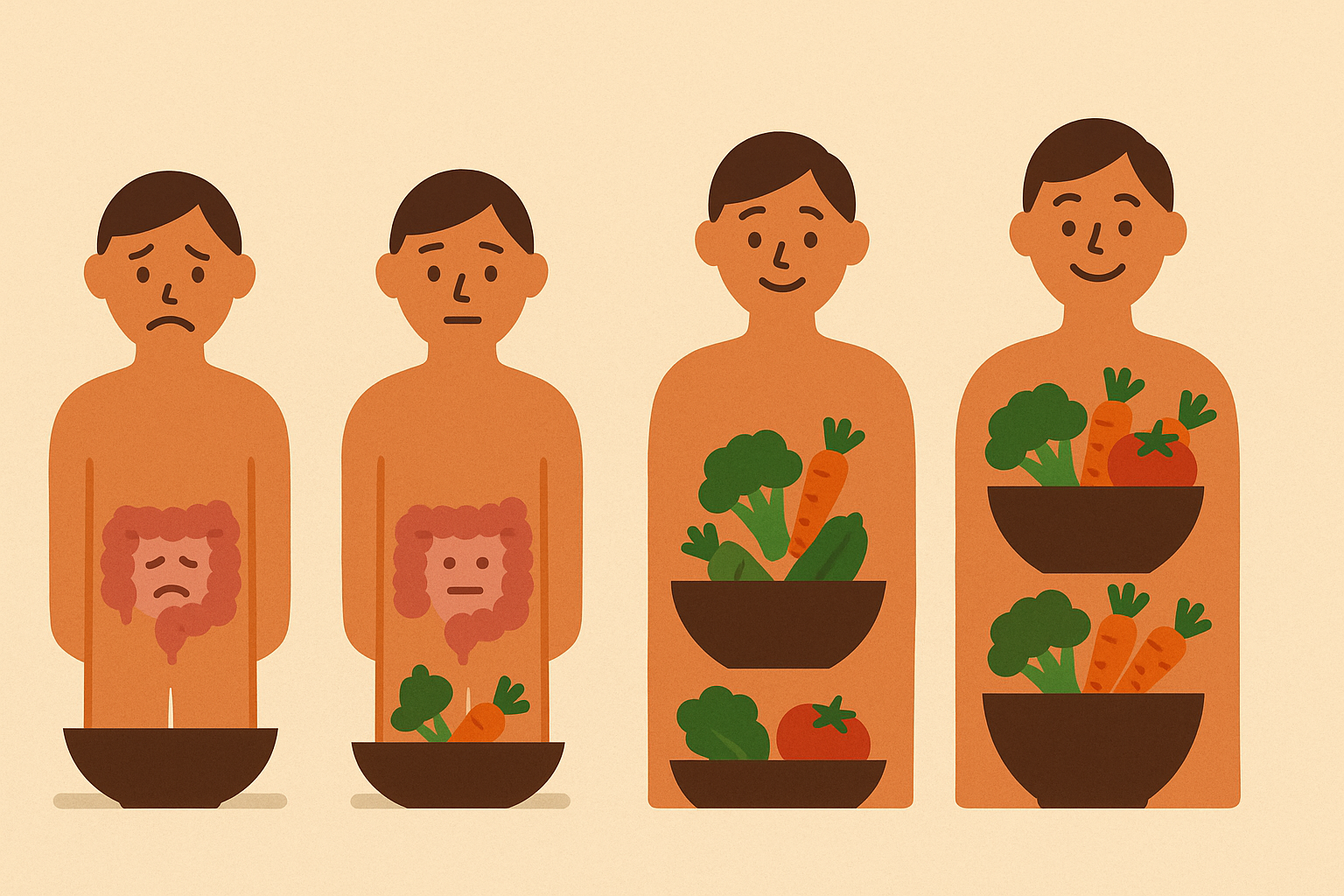
The 35-40 gram daily fiber target represents the sweet spot where you really notice a difference in how you feel. However, reaching this threshold safely requires understanding which foods pack the most fiber punch and building up slowly to avoid digestive disaster.
While most people focus on protein intake, research shows that dietary fiber is the real macronutrient you need to watch, making the fiber target crucial for optimal health outcomes.
I’ll be honest – when I first heard about aiming for 35-40 grams, I thought it was impossible. Most Americans get maybe 15 grams on a good day. But once you understand which foods are fiber powerhouses and have the right strategy, hitting your target becomes surprisingly manageable.
Understanding Which Foods Pack the Biggest Punch
Most people fail to reach their fiber goals because they don’t know which foods give you the most bang for your buck. Smart selection of high-fiber foods allows you to reach your target without eating massive amounts of food.
| Food Source | Fiber per 100g | Realistic Serving | Fiber per Serving | Calories per Serving |
|---|---|---|---|---|
| Chia Seeds | 34g | 2 tbsp (28g) | 9.5g | 138 |
| Psyllium Husk | 85g | 1 tbsp (10g) | 8.5g | 35 |
| Acacia Fiber | 90g | 1 tbsp (12g) | 10.8g | 43 |
| Black Beans | 15g | 1 cup (172g) | 15g | 227 |
| Artichoke | 8.6g | 1 medium (120g) | 10.3g | 64 |
This table changed everything for me. Once I realized that a single tablespoon of psyllium husk provides more fiber than most people get in an entire day, reaching my fiber goals suddenly seemed doable.
Your High-Fiber Arsenal
Focus on chia seeds, psyllium husk, and beans as concentrated sources that let you hit high fiber numbers without eating enormous amounts of food. These sources provide maximum fiber impact with minimal effort.
The beauty of these concentrated sources is that they’re virtually tasteless when mixed properly. You can hit massive fiber targets without dramatically changing your existing meal structure or dealing with the social awkwardness of eating huge salads at every meal.
The 80/20 Approach That Actually Works
Get 80% of your fiber target through concentrated sources like seeds and supplements, saving 20% for whole food sources to keep your meals enjoyable. This approach ensures you hit your targets while keeping your diet sustainable and social.
This distribution strategy prevents getting enough fiber from taking over your entire life. You can still enjoy normal meals and social dining while hitting your fiber targets through smart choices.
Building Up Slowly Over Several Weeks
Jumping directly to 35-40 grams causes digestive rebellion and makes you feel terrible. Successful people follow a gradual build-up over several weeks that allows your gut to adapt, preventing the bloating, gas, and digestive distress that make most people quit.
Simple Build-Up Plan:
- ☐ Week 1-2: Start with 15-20g daily, focus on gentle fibers like oats
- ☐ Week 3-4: Increase to 25-30g daily, add beans and resistant starch
- ☐ Week 5-6: Reach 35-40g daily, introduce more complex fibers
- ☐ Notice how you feel – energy, digestion, sleep
- ☐ Drink more water – seriously, this is crucial
- ☐ Track what works and what doesn’t for your body
This gradual approach is absolutely critical for success. I’ve seen too many people try to jump straight to high fiber intake and end up with such severe digestive distress that they abandon the entire approach.
Weeks 1-2: Getting Your Feet Wet
Start with gentle fibers like oat beta-glucan and apple pectin, paying attention to how your body responds daily. This phase allows your existing bacterial populations to adapt and multiply before introducing more challenging fiber types.
During these first two weeks, your gut bacteria are essentially learning what to expect. They’re ramping up enzyme production and adjusting their processes to handle increased fiber loads. Patience during this phase pays massive dividends later.
Weeks 3-4: Building Your Capacity
Add beans, resistant starch, and other complex fibers while making sure to drink plenty of water to prevent digestive backup. This phase builds on your foundation while gradually challenging your system with more complex fiber structures.
The water requirement becomes crucial during this phase. I learned this the hard way after experiencing severe constipation when I increased my fiber without proportionally increasing my water intake. Drinking more water prevents this completely.
Weeks 5-6: Reaching Your Sweet Spot
Reach full capacity through smart timing and food combinations, fine-tuning based on how your individual body responds. This final phase represents your transition to maintenance mode where higher fiber intake becomes your new normal.
By week 6, getting enough fiber should feel natural and effortless. Your digestive system has adapted, your bacterial populations have optimized, and you should be experiencing the full range of benefits that come with optimal fiber intake.
Making It Work in Real Life: Practical Strategies
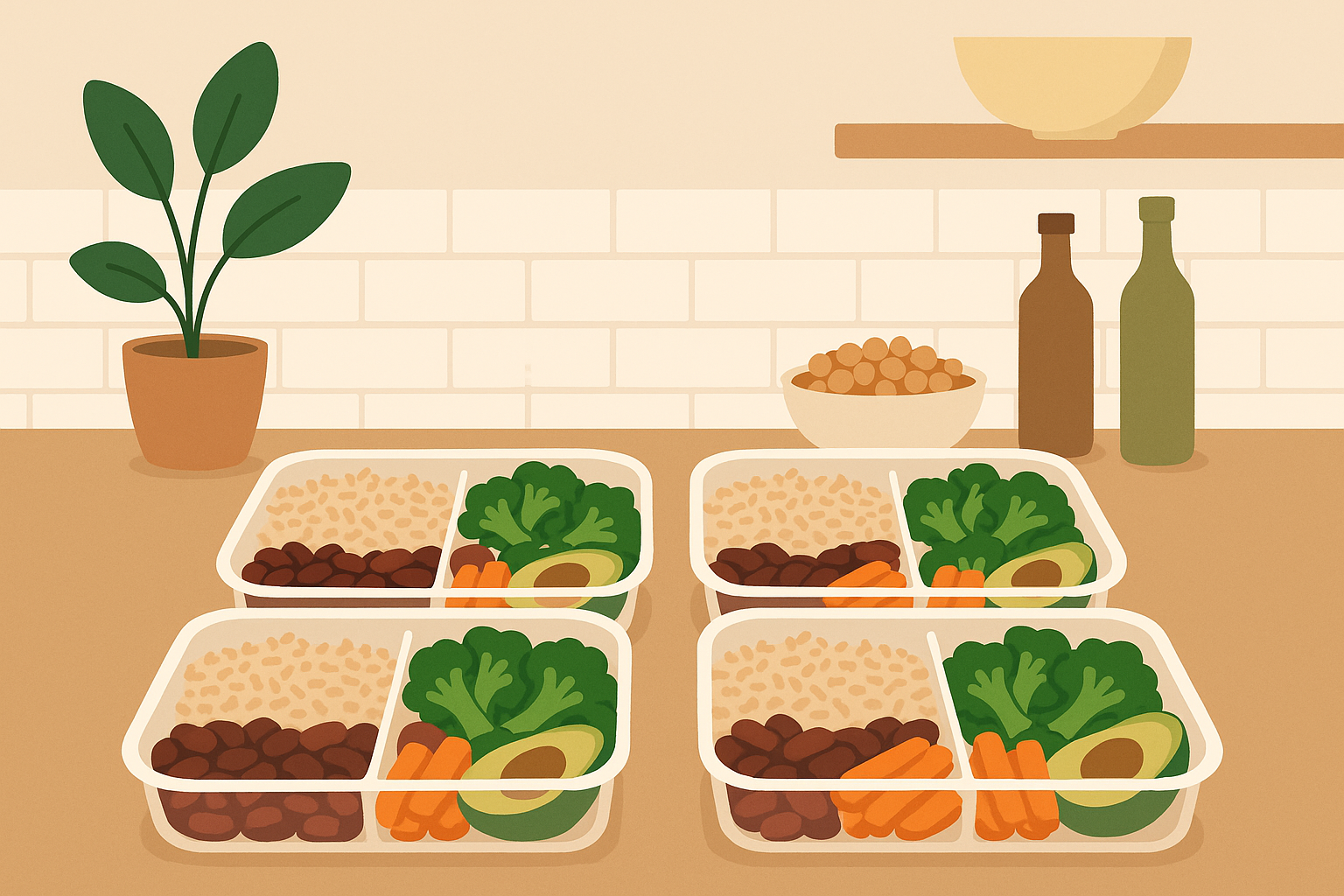
Sustainable fiber strategy requires seamless integration into existing routines through simple habits, meal prep strategies, and knowing how to handle social situations. The key is developing systems that maintain your approach even when life gets crazy without making you the weird health person at every gathering.
The biggest challenge with getting enough fiber isn’t the science – it’s the practical implementation. How do you maintain your routine when you’re traveling for work? What do you do at dinner parties? How do you handle the logistics without becoming that person who brings their own food everywhere?
Stealth Fiber Integration
Smart practitioners incorporate fiber invisibly into existing meals and beverages, maintaining their routine even in challenging social or travel situations. This approach prevents the social awkwardness and inconvenience that often derail well-intentioned fiber efforts.
Upgrading Your Daily Drinks
Transform daily beverages into fiber delivery systems using tasteless, mixable fibers that dissolve completely without changing texture or flavor. This allows you to hit significant portions of your fiber target through drinks you’re already consuming throughout the day.
Lisa, a busy attorney, struggled to maintain her fiber intake during long court days. She developed a simple system: 1 tablespoon of acacia fiber in her morning coffee (10g fiber), psyllium husk in her afternoon smoothie (8g fiber), and chia seeds in her evening herbal tea (5g fiber). This gave her 23g of her daily target through beverages alone, without anyone noticing or disrupting her professional routine.
This approach is brilliant because it uses existing habits. You’re already drinking coffee, smoothies, and tea – you’re just upgrading them to support your fiber goals.
Making Your Protocol Travel-Proof
Keep fiber targets during travel using portable, airport-friendly fiber sources and knowing where to find fiber-rich foods at your destination. This ensures your progress doesn’t get derailed by business trips, vacations, or other travel disruptions.
I keep individual packets of acacia fiber and psyllium husk in my travel bag at all times. These pass through airport security without issues and can be mixed into any beverage or soft food. This simple preparation has saved my fiber routine countless times during unexpected travel situations.
Navigating Social Situations

Maintain your fiber strategy during social dining, family meals, and professional events without drawing attention or compromising relationships. The goal is developing strategies that allow you to stick to your routine while remaining socially normal and enjoyable to be around.
Social situations used to stress me out because I worried about maintaining my fiber intake. Now I have simple systems that work seamlessly without making me the weird health person at every gathering.
Look, you don’t need to be perfect. If you’re at your friend’s birthday dinner, just enjoy the meal and get back to your routine the next day. Progress beats perfection every time.
Troubleshooting When Things Go Wrong
Most people experience digestive distress when increasing fiber because they go too fast, don’t drink enough water, or ignore their body’s signals. Understanding these common issues allows you to troubleshoot problems and adjust your approach for your unique body.
When getting enough fiber causes digestive issues, understanding why fiber is so good for your health helps maintain motivation while you troubleshoot and adjust your approach for better tolerance.
The reality is that fiber strategy doesn’t work perfectly for everyone right away. Individual variations in genetics, existing gut bacteria, and digestive capacity mean that some people need customized approaches to achieve optimal results.
Understanding Your Body’s Unique Response
Your genetic makeup and existing gut bacteria determine your optimal fiber types and how quickly you can increase intake. This individual component explains why some people thrive on certain fiber approaches while others struggle, making personalization crucial for success.
People with certain genetic variations can typically handle higher starch loads and may respond better to resistant starch approaches. Those with different genetics might need to emphasize other fiber types for optimal results.
Preventing Serious Digestive Issues
Gradually increase fiber over 4-6 weeks while paying attention to digestive symptoms to prevent small intestinal bacterial overgrowth during the transition. SIBO can derail your progress and create long-term digestive issues if not properly managed during the adaptation phase.
SIBO is probably the most serious complication that can arise during fiber increases. The key is recognizing early warning signs – excessive bloating within 30 minutes of eating, sulfur-smelling burps, and upper abdominal discomfort – and backing off your fiber intake immediately if these occur.
Tracking Your Individual Response
Keep track of specific fiber types, amounts, timing, and how you feel using a simple log to identify your unique optimal fiber profile and avoid problematic combinations. This systematic approach helps you identify patterns and optimize your approach based on your body’s specific responses.
I maintain a simple notes app tracking fiber type, amount, timing, and digestive response for each day. After a few weeks, clear patterns emerge that allow you to optimize your fiber approach based on actual data rather than guesswork.
Advanced Monitoring for Those Who Want to Go Deeper
Serious fiber enthusiasts track specific biomarkers to optimize their approach and measure success beyond just feeling better. This data-driven approach allows you to make informed adjustments and quantify the benefits of your fiber efforts.
Tracking Your Gut Changes
Regular stool microbiome analysis reveals bacterial population changes and helps adjust fiber types to maintain optimal diversity and beneficial bacterial ratios. This testing provides objective feedback on whether your approach is creating the desired bacterial changes.
Research shows that “plasma concentrations of butyrate, acetate and propionate increased over 25 hours post-meal, suggesting long-lasting effects post-meal” when consuming personalized fiber supplements, demonstrating the measurable impact of strategic fiber intake.
I get microbiome testing done every 6 months to track how my bacterial populations are responding to my fiber approach. The data helps me fine-tune my strategy and provides concrete evidence that the approach is working at the bacterial level.
Monitoring Overall Health Improvements
Monitor fasting glucose, inflammatory markers like CRP, and lipid profiles to quantify the systemic benefits of your fiber strategy and make data-driven adjustments. These biomarkers provide concrete evidence of your approach’s effectiveness beyond digestive improvements.
My quarterly blood work consistently shows improvements in inflammatory markers and metabolic health parameters that correlate directly with my fiber consistency. This objective feedback keeps me motivated and helps me optimize my approach based on measurable outcomes.
Final Thoughts
Getting enough fiber isn’t just about eating more vegetables or adding a supplement to your routine. It’s about understanding that your digestive system is a complex ecosystem that responds to strategic inputs in predictable ways. When you approach fiber intake with intention and patience, the results extend far beyond digestion.
The 35-40 gram threshold isn’t arbitrary – it’s the sweet spot where you really notice a difference in how you feel. But getting there requires patience, strategy, and a willingness to track how your individual body responds. Your genetics, current gut bacteria, and lifestyle factors all influence how you should approach fiber intake, making personalization crucial for long-term success.
Remember that this is a marathon, not a sprint. The people who succeed with getting enough fiber are those who build sustainable systems, track their progress honestly, and adjust their approach based on real feedback rather than assumptions. Your gut health influences everything from your mood and energy levels to your skin clarity and athletic performance – making the investment in strategic fiber intake one of the highest-leverage health interventions you can make.
After two years of consistent fiber focus, I can honestly say it’s transformed not just my digestion, but my entire quality of life. The energy stability, mental clarity, and overall sense of vitality I experience now makes the initial effort and learning curve completely worthwhile.
Will this change your life overnight? Probably not. But after a few months of eating more fiber consistently, you’ll likely feel more regular, have better energy, and just feel… better overall. And honestly, that’s pretty great.

